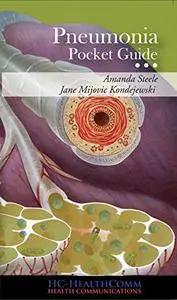Pneumonia Pocket Guide: Full Illustrated by HC-HealthComm
English | February 29, 2016 | ISBN: N/A | ASIN: B01CF5XQWG | 90 pages | EPUB | 1.83 Mb
English | February 29, 2016 | ISBN: N/A | ASIN: B01CF5XQWG | 90 pages | EPUB | 1.83 Mb
Chapter 1: Introduction
Pneumonia Prevalence and Epidemiology
Pneumonia is a potentially serious infection of the lung that is most commonly caused by a bacteria or virus. When the immune system responds to the bacteria or virus that has invaded the lung, the alveoli, air sacs in the lung that facilitate oxygen exchange, fill up with pus and fluid, and become swollen (inflamed) making it difficult to breathe (Figure 1.1).
Although anyone can develop an infection that leads to pneumonia certain groups are at higher risk including: adults over 65 years of age; children under 5 years of age; patients with chronic conditions like cancer, diabetes or chronic heart disease; and patients with compromised immune systems such as HIV patients.
Table of Contents
Abbreviations
Chapter 1: Introduction
Pneumonia Prevalence and Epidemiology
Types of Pneumonia
Community Acquired Pneumonia
Hospital Acquired Pneumonia
Health Care Associated Pneumonia
Atypical Pneumonia
Common Pathogens
Bacterial Pathogens
Viral Pathogens
Conclusion
Chapter 2: Pneumonia Physiology and Pathophysiology
Normal Lung Structure and Function
Pathophysiology of Pneumonia
Conclusion
Chapter 3: Genetics and Epigenetics of Pneumonia
Genetic Regulation of the Host Inflammatory Response to Pneumonia
Functional Polymorphisms
ACE deletion mutation
Antigen Recognition Polymorphisms
Mannose Binding Lectin (MBL)
TLR4 Polymorphisms
FcγRII Mutations
Inflammatory Cytokine Polymorphisms
TNFα Genetic Polymorphisms
Anti-Inflammatory Cytokine Polymorphisms
IL-10 Genetic Polymorphisms
Epigenetics and Pneumonia
Histone Modifications and Bacterial Colonization
Histone Modifications and Immune Evasion
Histone Modification and the Immune Response
Conclusion
Chapter 4: Pneumonia Guidelines and Diagnosis
National and International Guidelines for Community Acquired Pneumonia
CAP Assessment and Diagnosis
Severity Indices
Pneumonia Severity Index
CURB-65
Childhood Pneumonia
HAP Assessment and Diagnosis
Diagnostic Tests
Confirming a Pneumonia Diagnosis
Identifying the Causative Agent of the Infection
Conclusion
Chapter 5: Management and Treatment of Pneumonia
Community Acquired Pneumonia Disease Management and Treatment
Hospital Acquired Pneumonia Disease Management and Treatment
Childhood Pneumonia Disease Management and Treatment
Prevention Strategies
Pharmacotherapy
Antibiotics
Antivirals
First Line Therapies for Adult CAP
First Line Therapies for HAP
First Line Therapies for Childhood Pneumonia
Conclusion
Chapter 6: Recent Advances
Biotechnological Advances in Pneumonia Prevention
Endotracheal Tube Design Advances
Advances in Biomarkers for Pneumonia
Inflammatory Cytokines
Inflammation Response Proteins
Stress Response
Advances in Pneumonia Treatment
Statin Use to Treat Pneumonia
Next Generation Antibiotics
Ceftaroline
Cethromycin
Solithromycin
Nemonoxacin
JNJ-Q2
Conclusion
Chapter 7: Selected Links to Pneumonia References
Selected References
Feel Free to contact me for book requests, informations or feedbacks.
Without You And Your Support We Can’t Continue
Thanks For Buying Premium From My Links For Support
Without You And Your Support We Can’t Continue
Thanks For Buying Premium From My Links For Support



